During the 1940-41 season, the world seemed to want comedy and escapism. In a world that was getting more and more tense, this was understandable. Even though the USA was not yet a participant in the war going on in Europe, we had revived conscription, which became the subject of several cartoons from various studios.
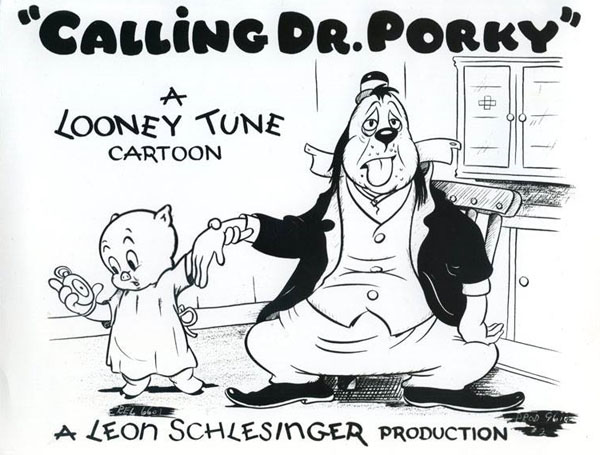
Calling Dr. Porky (9/21/40) – Porky is a doctor at New Rightus Hospital, which is being visited by an inebriate, who is himself being visited by three ghostly pink elephants (gray if you count the original black and white presentation). Porky compounds a prescription that cures the inebriate – but he still can’t shake the rosy pachyderms. Melodies on the track include “Jeepers Creepers” played in a minor key.
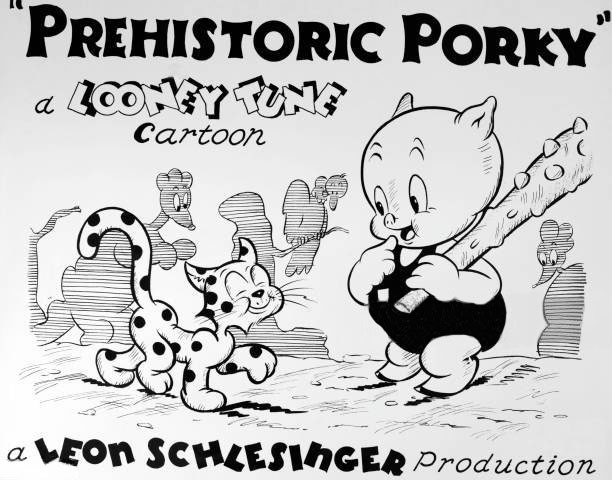
Prehistoric Porky (10/12/40) – perhaps inspired by Hal Roach’s One Million B.C. (1940), this sets a cave version of Porky among the dinosaurs and pterodactyls. After seeing articles in “Expire – the Magazine For Men” (a takeoff on Esquire magazine) about new men’s fashions, Porky decides to go hunting to acquire a new suit. Porky pursues a small leopard, but winds up pursued himself by a black panther – who ultimately makes Porky an offer: “I can get it for you wholesale!” Songs include “A Hunting We Will Go”, with special material lyrics, “Long Long Ago”, and “These Are Wonderful Days” with special lyrics.
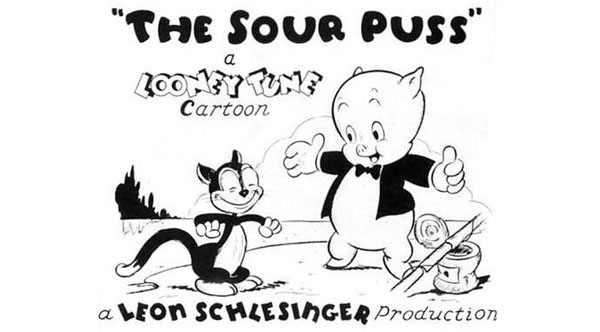
The Sour Puss (11/2/40) – Porky reads in the paper it’s the first day of fishing season, and decides to go fishing, sending his cat into ecstatic delight, and causing a canary to commit suicide with possibly the first use of Clampett’s standard line, “Well, now I’ve seen everything.” While on the outing, Porky and the cat meet a “daffy” flying fish, with a unique vibrato voice. The fish pulls the old “fin in the water” gag to impersonate a shark – with a real one taking his place when the cat tries to lift it up – itself lifted from Porky’s Naughty Nephew. Songs include “Meow”, “Chicken Reel”, “Rock a Bye Baby”, and “When the Swallows Come Back to Capristrano”, a song introduced in 1939 which became a hit in 1940, inspired by a radio report on St. Joseph’s Day festivities at San Juan Capistrano mission. Recordings include Ceelle Burke for Varsity and Ammor records, Glenn Miller for Bluebird, the Ink Spots on Decca, Gene Krupa on Decca, Guy Lombardo on Decca, Dick Todd on Bluebird, Tony Martin on Decca, both Gene Autry and Jack Leonard on Okeh, and on radio transcription by the King Sisters. The song was revied in 1957 by Pat Boone as the flip side of one his biggest hits (“April Love”). It became a go-to favorite of Carl Stalling whenever a reference to birds was needed.
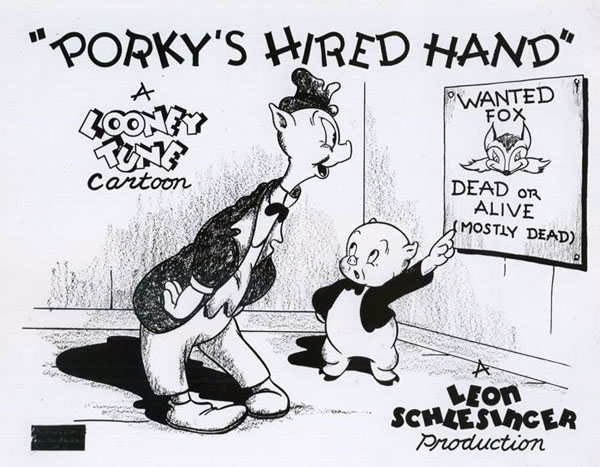
Porky’s Hired Hand (11/30/40) – Porky hires a real dufus (one Gregory), to watch over his chickens to keep them from being raided by a local fox (“I’m the guy they can’t catch.”) The fox collects a bag full of Porky’s pullets, and tries to dupe the gullable Gregory into letting him make off with them. But a mistaken use of the door to the incubator room instead of the exit puts the fox in a spot that is “too hot to handle”, and quickly reduces him to pipsqueak size. (”I’m a ruined man. You’ll hear from my lawyer.”) Songs: “Puddin’ Head Jones”, “We’re In The Money” and “Sleep, Baby, Sleep”.
The Timid Toreador (12/21/40) – Porky is a hot tamale vendor – and boy, are they ever hot. At the local bull ring, Porky is forced to confront “Slapsy Maxie Rosenbull” (another name twist on “Rosenbloom”). The bull gets ahold of some of Porky’s tamales, and exlodes – leaving Porky in a shower of sombreros, and doing his best visual impression of Oliver Hardy (or was it Solomon Swine from Case of the Stuutering Pig – he looks exactly the same). Songs include “La Cucaracha” (with special lyrics), “In Caliente”, “Muchacha”, and “The Gaucho Serenade” , recorded by both Paul Whiteman and Roy Smeck on Decca, both Glenn Miller and Dick Todd on Bluebird, both Eddy Duchin and the Charioteers on Columbia, and in England by Harry Roy on Parlophone, Joe Loss on HMV, and Fud Candrix in Belgium on Telefunken
Porky’s Snooze Reel (1/11/41) – Spot gag parody of newsreels (as if we didn’t get enough of these from Fleischer). Songs: “The Animal Fair”; “We’re in the Money”; “Listen to the Mocking Bird”; “Deep River”, a spiritual recorded by Paul Robeson for Victor; “The Girl I Left Behind Me”, “Song of the Marines”, “Aloha Oe”; and possibly the first use of “Trade Winds”, recorded by Bing Crosby for Decca, and to become another Stalling semi-standard.
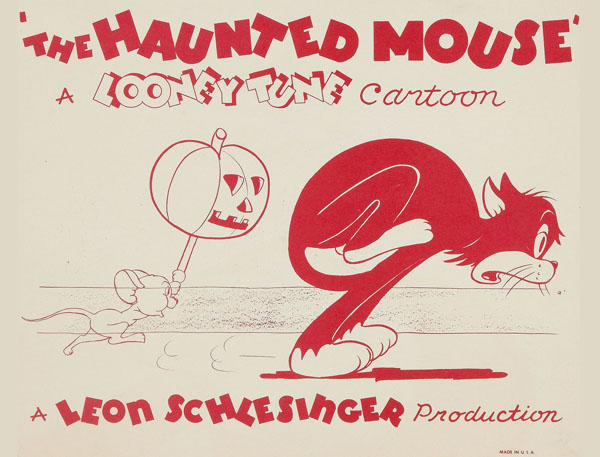
The Haunted Mouse (2/15/41) – A hungry cat decides to go to a restaurant he sees advertised on a desert sign. He doesn’t realize the old restaurant is in the middle of a ghost town, and inhabited by a ghost mouse bent on revenge. The score includes “Ain’t We Got Fun”, and possibly the first use by Stalling of “Angel In Disguise”, introduced by Ann Sheridan in the feature “It All Came True”, and recorded by Dick Todd on Bluebird, Bob Crosby on Decca, Ozzie Nelson for Bluebird, and Horace Heidt for Columbia.

Joe Glow the Firefly (3/8/41) – Another moody Chuck Jones piece using only an original score with no recognizable popular songs. Basically an anatomy lesson, as a small firefly inspects the camp (and person) of a sleeping camper.
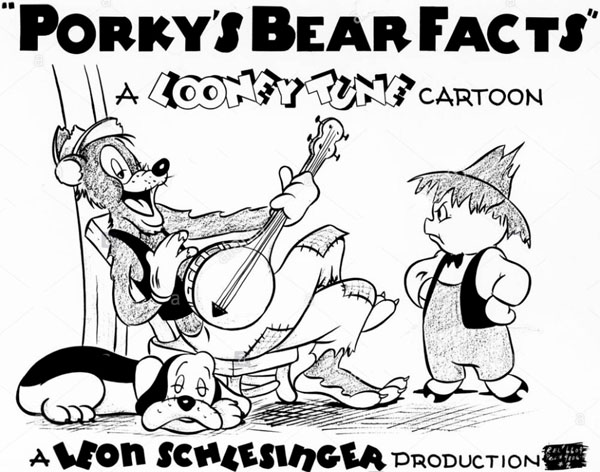
Porky’s Bear Facts (3/29/41) – Another retelling of the “Grasshopper and the Ants”, with industrious Porky in the ant role (singing about the rewards of work), while a neighboring bear and his dog play the grasshoppers (singing a ballad in tribute to doing nothing, worked to the melody of a popular tune, “Heaven Can Wait”, rewritten as “Working Can Wait”). In Winter, the bear begins to envision his dog as his next dinner – until the opportunity arises to mooch food from Porky instead – then go right back to goofing off. Glen Gray recorded “Heaven Can Wait” to reach #9 on the Billboard charts for Decca. It was also covered by Kay Kyser on Brunswick, Tommy Dorsey for Victor, Mitchell Ayres and his Fashions in Music for Vocalion, and in an aircheck by Glenn Miller. It was covered for the Dutch market by Hal Yates and the Het Ramblers Dansorkest on Panachord. Also included , “The Girl With the Pigtails In Her Hair” (with specialty lyrics for Porky), recorded by Hal Kemp on Victor, Horace Heidt on Columbia, Lawrence Welk on Vocalion, Charlie Barnet on Bluebird, and Bing Crosby on Decca; and “All This and Heaven Too”, reorded by Tommy Dorsey on Decca with vocal by young Frank Sinatra.
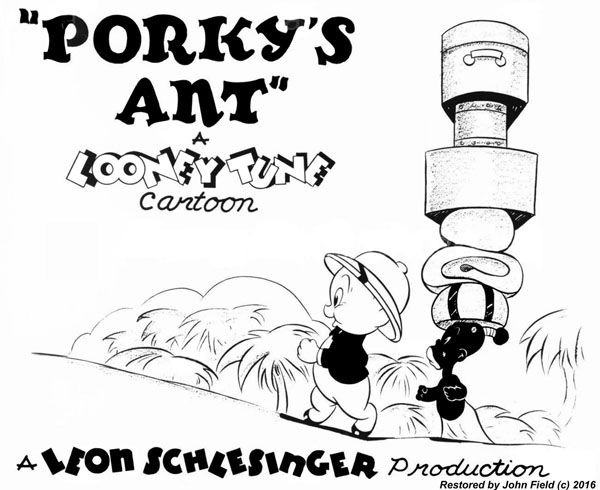
Porky’s Ant (5/10/41) – Porky goes into the jungle in search of a rare Pygmy ant (only worth a mere $150,000.00, as compared to the endless number of zeroes affixed to the cost of the dodo bird hunted previously). Porky and his bearer find their quarry, who lusts after a bone the bearer wears in his topknot (as the ant has obnly a particularly small one). The chase is on, and eventualluy a lion gets involved. The ant fends off the lion, for which Porky and the bearer present the bearer’s bone as a reward. Songs: “Congo” and “Sweet Georgia Brown”.
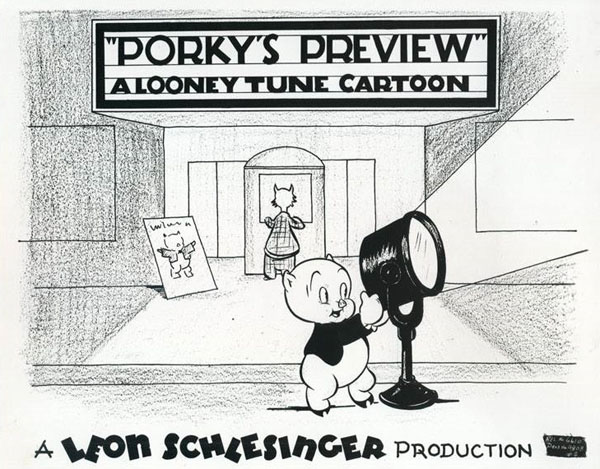
Porky’s Preview (5/23/41) – Porky presents his own animated cartoon, done in stick-figure drawings (no doubt, a great budget cutter for the animators). Gags also come from the audience, including a skunk who only has “one scent” to get in. Music includes “California, Here I Come” and “September In the Rain” (in the style of Al Jolson in his traditional blackface).
 A Coy Decoy (6/7/41) – Sort of a forerunner to Clampett’s 1946 masterpiece Book Revue – it’s midnight in a book shop, with Daffy as the Ugly Duckling. The usual chase, with the chaser being The Wolf of Wall Street, utilizing a wind-up duck decoy as a lure, for which Daffy goes gaga. At the end, Porky scoffs at the relationship between Daffy and the fecoy – only to be razzed by one of a quartet of newly-arrived wind-up baby ducklings!. Songs include “In an Old Dutch Garden”, “Ride, Tenderfoot Ride”, Chopin’s “Moonlight Sonata” (used to set the mood in the opening), “The Old Apple Tree” (with specialty lyrics for Daffy as “I Can’t Get a Long Little Doggie”), “Cheyenne” (heard over an often censored “Black Beauty” gag, lifted from Friz Freleng’s “The Bookworm” at MGM), “The Kiss Waltz” (heard over Daffy’s romantic monologue), “We’re In the Money”, and “Taps”.
A Coy Decoy (6/7/41) – Sort of a forerunner to Clampett’s 1946 masterpiece Book Revue – it’s midnight in a book shop, with Daffy as the Ugly Duckling. The usual chase, with the chaser being The Wolf of Wall Street, utilizing a wind-up duck decoy as a lure, for which Daffy goes gaga. At the end, Porky scoffs at the relationship between Daffy and the fecoy – only to be razzed by one of a quartet of newly-arrived wind-up baby ducklings!. Songs include “In an Old Dutch Garden”, “Ride, Tenderfoot Ride”, Chopin’s “Moonlight Sonata” (used to set the mood in the opening), “The Old Apple Tree” (with specialty lyrics for Daffy as “I Can’t Get a Long Little Doggie”), “Cheyenne” (heard over an often censored “Black Beauty” gag, lifted from Friz Freleng’s “The Bookworm” at MGM), “The Kiss Waltz” (heard over Daffy’s romantic monologue), “We’re In the Money”, and “Taps”.
Porky’s Prize Pony (6/21/41) – Porky works at a stable as both groom and jockey, where he is bedeviled by a persistent horse (a superlatively clumsy nag) who wants to be adopted – a definite precursor to Jones’ “Charlie Dog” series to come. The horse’s approach to steeplechasing is more prone to barreling through than jumping over, but the horse eventually wins first prize – though his picture is taken in the winner’s circle with all four hoofs stuck in a bucket. Songs include “The Old Gray Mare”, and a specialty lyric version of “We’re In the Money” as Porky sings of his happiness at riding a favorite for a $10,000 purse (until, of course, the wanna-be adoptee horse accidentally spikes the favorite’s water with horse liniment – 125% alcohol).
Meet John Doughboy (7/5/41) – Spot gags on military life, with Porky appearing in only one shot. Otherwise, it’s formatted as another newsreel spoof on preparedness for war – and one of the first cartoons to spoof “Citizen Kane” as “Citizen Sugar Kane”, stating that our open door policy is responsible for the draft. Also spoofs a Pall Mall slogan of the day – “Mine’s longer than yours”. Mostly patriotic tunes, including “America”, “Columbia, the Gem of the Ocean”, and “You’re In the Army Now”.
We, the Animals, Squeak (8/2/41) – A spoof of “We the People”, a radio show in which ordinary people told extraordinary stories. Our narrator is one “Kansas City Kitty” – playing on the titles of two songs which were not under Warner’s owership – “Kitty From Kansas City”, introduced by Rudy Vallee, and “Kansas City Kitty”, recorded by Noble Sissle for HMV Billy Murray for Victor, and Coon-Sanders Orchestra for Victor. The film includes some material I’m surprised passed the Hayes Office, including a reversal of order of pages in a family albim, showing the arrival of baby kitten Patrick before the photo of Kitty’s wedding! Adter a harrowing tale of kidnapping and blackmail, Kitty routes a flock of evil rats – at least in her story. But when Porky presents her with a mouse as a prize for her story, she reverts to the form of the “average” housewife, climbing atop a stool and attempting to shoo the fearsome creature away. Most notable new song is “Playmates”, a Saxey Dowell novelty that looked like it would be as successful as his “Three Little Fishies” of two years earlier. The song was most notably recorded by Kay Kyser on Columbia (and would become the title of one of his RKO pictures), and also covered by Ray Herbeck on Vocalion, Mitchell Ayres on Bluebird, with a second version in the Bluebird country series by Riley Puckett, Dick Robertson on Decca, and Hal Kemp on Victor (featuring the composer on sax). The song was found to be an infringement on the song “My Own Iola”, a psuedo-Hawaiian number written around 1907 by Percy Wenrich.

The Henpecked Duck (8/30/41) – Porky as judge in the “court of Inhuman Relations”, where four words are heard more than any other – “I want a divorce!”. The case of Duck vs. Duck pits Daffy against the missus, for losing their offspring egg through a negligent bit of ledgerdemain, causing it to disappear. This film has been reviewed on this site previously in the “Holy Matrimony! And a “Stack of Storks” columns on the Animation Trails series. One of the first Clampett cartoons to make heavy use of the “Beoowoop” vocal effect whenever the disappearing trick takes place. Songs include the Bridal Chorus from Lohengrin, “Over the Waves”, and “Old Black Joe” (in a particularly dragging arrangement to mirror Daffy’s dejected mood).
Next Time: Merrie Melodies 1940-41: There’s a New Star in Hollywood Tonight.


 James Parten has overcome a congenital visual disability to be acknowledged as an expert on the early history of recorded sound. He has a Broadcasting Certificate (Radio Option) from Los Angeles Valley College, class of 1999. He has also been a fan of animated cartoons since childhood.
James Parten has overcome a congenital visual disability to be acknowledged as an expert on the early history of recorded sound. He has a Broadcasting Certificate (Radio Option) from Los Angeles Valley College, class of 1999. He has also been a fan of animated cartoons since childhood.











































“Heaven Can Wait” was also used in another “Grasshopper and the Ant” bit by Freleng ( Foney Fables).
Carl Stalling’s score to “Joe Glow the Firefly” isn’t entirely original; he had some help from his old friend Felix Mendelssohn.
The music over the opening credits is the second theme from Mendelssohn’s Overture to “A Midsummer Night’s Dream”, which he composed at the age of 17. The “hee-hawing” motif in the violins signifies Bottom the weaver. Later in the cartoon, when Joe is fooling with the pepper shaker, the music is the Fairy March (not to be confused with the Wedding March) from Mendelssohn’s incidental music to that play, composed many years after the overture.
The melody in the oboe at the beginning (and near the end) of the cartoon is “On Wings of Song”, Mendelssohn’s setting of a poem by Heinrich Heine. (Another of Heine’s poems, “Die Lorelei”, set to music by Friedrich Silcher, is sometimes heard in old cartoons during scenes involving mermaids.) Mendelssohn’s melody was later provided with new lyrics by Paul Francis Webster as “Till My Loves Comes to Me”, sung by Doris Day in the film “Young at Heart” and on its Columbia Records soundtrack album. It’s a beautiful song, maybe worth embedding here.
The “Moonlight Sonata”, heard in “A Coy Decoy”, is by Beethoven, not Chopin.
“Playmates”! When I was in elementary school in the late sixties, girls in my school used to sing that song in pairs, accompanying themselves with a sort of pat-a-cake hand-clapping routine. One of them must have learned it from her mother and passed it along to the others. I assumed it was an old nursery rhyme like “Ring around a rosey”; I had no idea it was a hit song and a movie musical!
“Playmates” also gets a reference at the start of “Porky’s Preview”, while we supposedly get a Thurl Ravenscroft sighting as the baritone doing the ‘There Are Wonderful Days’ number in “Prehistoric Porky”. The 1940-41 season was also the release year where Carl Stalling spent some time tinkering with the musical arrangements for both “The Merrie Go Round Broke Down” and “Merrily We Roll Along” on the LT and MM series, before settling on the versions that would last through the rest of Leon Schlesinger’s time at the studio and the arrival of the expanded animation credits in 1945 (the alternate version used only on “Joe Glow, the Firefly” also contains hints of the revised “Merrie Go Round Broke Down” theme that Stalling and Milt Franklyn would adopt following the studio’s reopening at the end of 1953),.
I don’t know about Thurl Ravenscroft, but the lead singer in “These Are Wonderful Days” is doing a takeoff on Jerry Colonna.
Additional notes: “Joe Glow the Firefly” uses no contemporary cues but it does feature numerous classical pieces by Felix Mendelssohn.
“Porky’s Bear Facts” also used “Then Came the Rain” by Oscar Levant: https://www.youtube.com/watch?v=NIwBduolO9c
And a question about “We, the Animals, Squeak!”: One song I’ve been trying to identify for years: https://www.youtube.com/watch?v=9ibl8v6FK5w&t=8m28s . It’s also heard in a few Milt Franklyn-scored shorts, such as “Mixed Master”, “Red Riding Hoodwinked” and “Hare Brush”. Anyone know it (if it’s anything)?
The Henpecked Duck is, without question, the darkest Looney Tunes film of all time. The entire atmosphere of the short is astonishingly grim. Unlike His Bitter Half, there is no humor to be found in Daffy’s domestic situation. He is utterly miserable being tied down and top of that, he is a painfully inept father. His child’s “disappearance” is not the least bit funny in my pov. There was no way that this short did not illustrate Clampett’s own fears of being an henpecked husband and his terror of not being a decent father. That film is a confession or I’ll eat my hat.
Chow Hound and Fresh Airedale come to mind as two of the darker WB cartoons… As a kid, I always thought The Henpecked Duck was hilarious (even if I was too young to understand the lightbulb joke haha) However, I used to find some of the Bear family cartoons kind of unsettling when I was younger for some of the reason you mentioned but it’s all meant to be in good humor and are part of why the WB cartoons are still entertaining to watch as an adult
It’s an uncharacteristically dark cartoon for Clampett- divorce and being trapped in a loveless marriage aren’t really the funniest of subject matters- but let’s not forget Cheese Chasers and The Hypo-Chondri-Cat. Both deal with assisted suicide and terminal illness/death, not exactly light subjects either.
@Steph
Yes, the bear cartoons. I forgot about those. Papa Bear was based on Jones’ own father.
@Ian L.
I never found those cartoons very shocking or unsettling. They had an edge to them but never disturbing.
I must be that unusual child who found “Joe Glow the Firefly” absolutely charming as a kid (age 6 or 7, I guess when I first saw it). Similarly, referring to the earlier post about Revolutionary War cartoons, I thought “Old Glory” was wonderful at that age, possibly because I was enthralled by the use of rotoscoping, before I knew what it was.